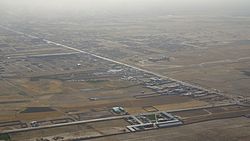Balkh province
| Balkh | |
|---|---|
| Province | |

Aerial view of a road leading to Mazar-i-Sharif in Balkh Province
|
|
 Map of Afghanistan with Balkh highlighted |
|
| Coordinates: 36°45′N 67°0′E / 36.750°N 67.000°ECoordinates: 36°45′N 67°0′E / 36.750°N 67.000°E | |
| Country |
|
| Capital | Mazar-i-Sharif |
| Government | |
| • Governor | Atta Muhammad Nur |
| Area | |
| • Total | 16,186.3 km2 (6,249.6 sq mi) |
| Population (2012) | |
| • Total | 1,245,100 |
| • Density | 77/km2 (200/sq mi) |
| Time zone | UTC+4:30 |
| ISO 3166 code | AF-BAL |
| Main languages | Dari, Pashto, Turkmen, Uzbek |
Balkh (Persian and Pashto: بلخ, Balx) is one of the 34 provinces of Afghanistan, located in the north of the country. It is divided into about twelve districts and has a population of about 1,245,100, which is multi-ethnic and mostly a Persian-speaking society. The city of Mazar-i-Sharif serves as the capital of the province. The Mazar-e Sharif International Airport and Camp Marmal sit on the eastern edge of Mazar-i-Sharif.
The name of the province is derived from the ancient city of Balkh, near the modern town. Home to the famous blue mosque, it was once destroyed by Genghis Khan but later rebuilt by Timur. The city of Mazar-e-Sharif has been an important stop on the trade routes from the Far East to the Middle East, the Mediterranean and Europe.
The city of Balkh and the area of Balkh Province was considered a part of various historical regions in history including Ariana and Greater Khorasan.
It serves today as Afghanistan's second but main gateway to Central Asia, the other being Shir Khan Bandar in neighboring Kunduz Province.
Balkh Province is situated in the northern part of Afghanistan, bordering Uzbekistan in the north, Tajikistan in the north-east, Kunduz Province in the east, Samangan Province in the south-east, Sar-e Pol Province in the south-west and Jowzjan Province in the west. The province covers an area of 16,840 km2. Nearly half of the province is mountainous or semi-mountainous terrain (48.7%) while half of the area (50.2%) is made up of flat land.
...
Wikipedia
